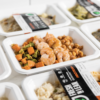You know that lunch is an important meal and that it can affect your overall health. But even after hearing all that lunch can do for you, you still have to learn how to “do lunch” right!
Sure, healthy eating is a big part of it, but there’s other things you might not have considered – where and when you eat, for one! And what exactly is “eating healthy?” Let’s answer these questions and give you a good starting point for what a proper lunch should look like.
What is “Eating Healthy?”
For everyone, the definition of healthy will change. A well-rounded diet is adjusted to the individual depending on their age, health concerns, and lifestyle. However, as a general guideline, a good place to start is seeking out foods that can fulfill most (if not all) essential food groups.
This means lean protein, fruits and vegetables, whole grains, and dairy to get the calories, carbohydrates, healthy fats, vitamins, and minerals to stay our mental and physical best. It also means avoiding refined and processed foods as much as possible.
What To Eat:

Here’s a list of the foods you might include in your lunch to help you construct your ideal healthy diet:
Vegetables: Leafy greens like lettuce or kale, starchy vegetables like potatoes or beets, legumes like black beans or peas, colorful root vegetables like carrots, onions, or radishes, and other things like cauliflower, zucchini, fennel, broccoli, or mushrooms.
Fruits: Tomatoes, apples, all types of berries, avocado, bananas, mangoes, melons, guava, and cherries.
Proteins: White fish including cod, haddock, halibut, tilapia, or bass, skinless chicken and turkey breast, beans, peas, and legumes, as well as eggs, tofu, nuts, Greek yogurt, and lean beef or pork.
Dairy: Low-fat and/or lactose-free options for cheese and milk, plant milks, soy milk, Greek yogurts, or cottage cheese
Whole Grains: Quinoa, buckwheat, barley, brown rice, farro, whole wheat pasta and breads, oats, and sometimes popcorn!
What To Avoid:
Avoid things like baked goods, fast food, white bread, soda, fried foods, processed meats, fruit drinks with added sugars, and other processed foods as much as possible! Indulging every now and then is okay, but a well-rounded diet should mostly consist of foods from the above list.
Right Place, Right Time

Where and when you eat can affect your eating habits. Most Americans say they eat at their desks and often check social media or the news during lunch. “Distracted” eating can cause you to consume more calories than you mean to. Studies have also proven that eating socially with coworkers or friends causes us to be more mindful of what we are eating so we have more control over our habits. Eating socially can also improve teamwork!
Timing when you eat also aids in better eating habits. Believe it or not, you feel your best when you eat about every 4-6 hours! Another key to successful eating is planning small, frequent meals to keep yourself full and happy. Think about what time you ate breakfast today. Has it been more than 4 hours? It might be time to eat your lunch!
What’s even more enticing is that people who take their lunch breaks every day feel more satisfied with their jobs, too! The next time you feel cranky at work, check the last time you ate!
Other Lunch Tips

Practicing these other lunch habits will help you make better lunch choices and keep you going strong. Though habits take time to build, they’re worth it in the long run. Give them a try!
- Bringing Your Own Lunch – Packing lunch is a surefire way to make sure you eat healthily every workday! Waiting until you feel hungry to think about what you want to eat makes you more likely to go for quick, likely processed, convenience food. Planning a menu for the week is an easy way to make sure you have control over your food selection, portion size, and availability – No more desperate, last-minute fast-food runs!
- Set a Schedule – Decide when you’ll have your meals and stick to a schedule! This ensures you never miss a meal and that you get your body used to a regimented eating schedule.
- Sit, Don’t Stand – Standing while eating has a connection to overeating! Take the time to relax, sit down, and practice mindful eating (that means putting away your phone).
- Choose Filling Foods – Complex carbohydrates take longer to digest, which means you feel fuller for longer after eating foods that retain their natural fiber profiles like whole wheat bread or sweet potatoes. High protein foods also work!
- BIG Lunch, Small Dinner – Opt for a filling lunch that can keep you satiated until dinnertime to avoid over snacking in the late afternoon.
- Make Healthy Swaps – Use olive oil instead of butter, skim milk instead of whole, honey with maple syrup, or brown rice instead of white to enjoy the same meals you love with healthy and just as tasty alternatives.
- Drink Water – Drinking a full glass of water half an hour before eating can help you feel fuller. And don’t forget that it’s easy to consume more sugar and calories with sodas, juice, and other sugary beverages.
- Use A Meal Delivery Service – Don’t have time to make food every day? A meal delivery service can cut hours out of your day while still getting you the nutrition you need to stay healthy.



